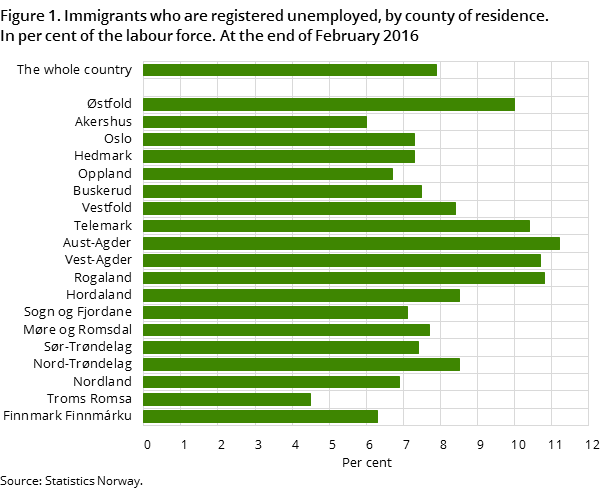Content
Published:
This is an archived release.
Strongest increase among men from the EU
Registered unemployment among immigrants increased from 7.6 per cent in February 2015 to 7.9 per cent in February 2016, while the unemployment rate went up from 2.2 to 2.4 per cent within the rest of the population. In the population as a whole, the unemployment rate was 3.3 per cent in February 2016.
| 1st quarter 2016 | Change last twelve months | |||
|---|---|---|---|---|
| Absolute figures | Per cent | 1st quarter 2015 - 1st quarter 2016 | ||
| Absolute figures | Percentage points | |||
| 1Non-residents included. | ||||
| 2Turkey is included. | ||||
| Registered unemployed, total | 90 902 | 3.3 | 9 370 | 0.3 |
| Non-immigrant population1 | 57 326 | 2.4 | 7 034 | 0.2 |
| Immigrants, total | 33 576 | 7.9 | 2 336 | 0.3 |
| The Nordic countries | 1 684 | 3.4 | 46 | 0.1 |
| Western Europe else | 2 097 | 4.6 | 303 | 0.6 |
| EU countries in Eastern Europe | 12 723 | 10.0 | 1 106 | 0.5 |
| Eastern Europe else | 2 656 | 7.3 | 58 | -0.1 |
| North-America and Oceania | 270 | 3.9 | 47 | 0.6 |
| Asia2 | 8 510 | 8.0 | 547 | 0.3 |
| Africa | 4 514 | 12.1 | 129 | -0.3 |
| South- and Central-Amerika | 1 122 | 8.3 | 100 | 0.6 |

Immigrants from non-Nordic countries in Western Europe and the EU countries in the east had the strongest growth in registered unemployment, of 0.6 and 0.5 percentage points respectively. Many immigrants from these regions work within the oil-related sector, which means that they are particularly affected by the reductions within these industries. On the other hand, immigrants from Africa and Eastern Europe outside the EU experienced a slight decrease in the unemployment rate during this period, by 0.3 and 0.1 percentage points respectively.
African immigrants still have the highest unemployment rate
Despite the decrease, immigrants from Africa still have the highest unemployment rate, at 12.1 per cent in the 1st quarter, which is due to the large percentage of refugees within this group. Next were immigrants from the EU countries in Eastern Europe with 10 per cent. Immigrants from Latin America and Asia had 8 per cent each, while those from Eastern Europe outside the EU had 7.3 per cent registered unemployed. As usual, the remaining groups had rates far below the immigrant average: Western Europe (4.6 per cent), North America and Oceania (3.9 per cent) and the Nordic countries (3.4 per cent).
Who are included in the statistics?
The unemployment figures, which in these statistics are based on unemployed persons registered with the Norwegian Labour and Welfare Organisation, only consist of persons with permission to stay in Norway, and who are registered as residents in Norway (in the Central Population Register). The large number of asylum seekers who came to Norway during the autumn of 2015 is not included in these figures. There is, however, a group of 2 200 unemployed people who are not registered as settled in Norway, but they are not counted as immigrants and consist mainly of people from the EU countries.
More than one third of the unemployed are immigrants
In total, 90 900 people were registered as unemployed in the 1st quarter of 2016. Of these, about 33 600 were immigrants, which is a share of 37 per cent of the total number of unemployed. This share was almost the same as in February 2015.
More unemployed men
Registered unemployment among male immigrants has increased over the past year from 7.8 to 8.4 per cent. Among men in the rest of the population, unemployment rose from 2.5 to 3.0 per cent. Among women, unemployment rates were unchanged within both population groups. The rates were 7.3 per cent (immigrants) and 1.8 per cent (rest of the population). The gender disparities are mostly due to the economic decline within the male dominated oil-industries.
Increase among participants on labour market schemes
A total of 1 880 more immigrants took part in labour market schemes in February 2016 than in February 2015, which is an increase of 33 per cent within this participant group. Participants without an immigrant background had an increase of 30 per cent. A total of 7 583 immigrants took part in labour market schemes in the 1st quarter of 2016, making up more than 43 per cent of the total participant group. Most of the immigrant participants were from Asia, Africa and EU countries in Eastern Europe.
Lower unemployment among Norwegian-born to immigrant parents than immigrants
Norwegian-born to immigrant parents is still a rather small group of unemployed persons. This group constituted 1 200 registered unemployed persons in the 1st quarter of 2016. A large share of this group is aged 15-29 years, and the unemployment rate within this age group was 4.7 per cent, which was about half of the rate within the immigrant group at the same age (at 9.3 per cent) and only 0.9 percentage points above the corresponding age group in the rest of the population (at 3.8 per cent).
Within the age group 15-29 years, the unemployment rate decreased slightly by 0.1 percentage points among the Norwegian-born to immigrant parents and went up by 0.5 and 0.3 percentage points among immigrants and the rest of the population respectively.
Additional information
The unemployment figures are based on the Norwegian Labour and Welfare Organisation’s register of jobseekers and are calculated as a share of the labour force, which is the sum of employed persons and registered unemployed persons, i.e. people offering their labour on the labour market.
Contact
-
Statistics Norway's Information Centre
E-mail: informasjon@ssb.no
tel.: (+47) 21 09 46 42
